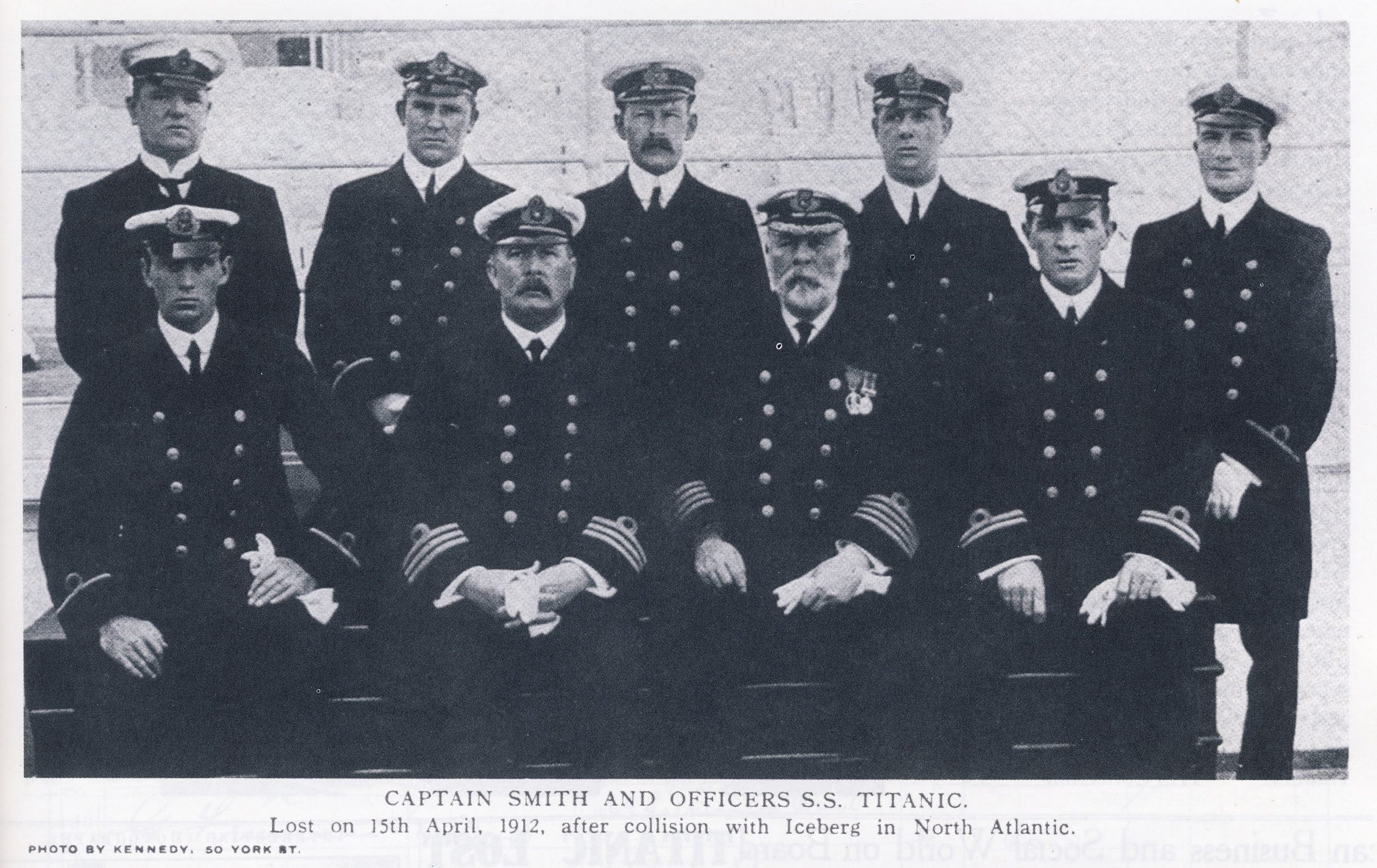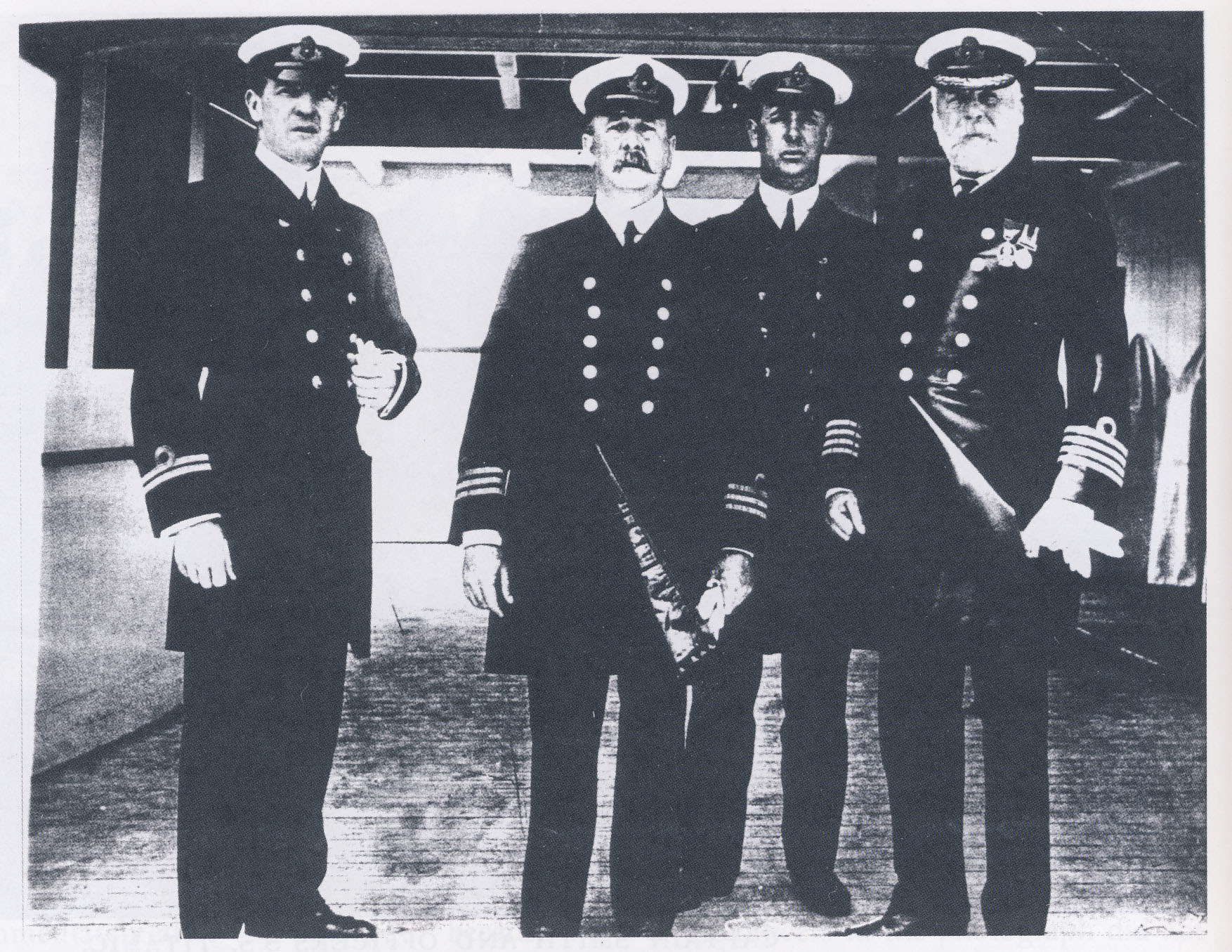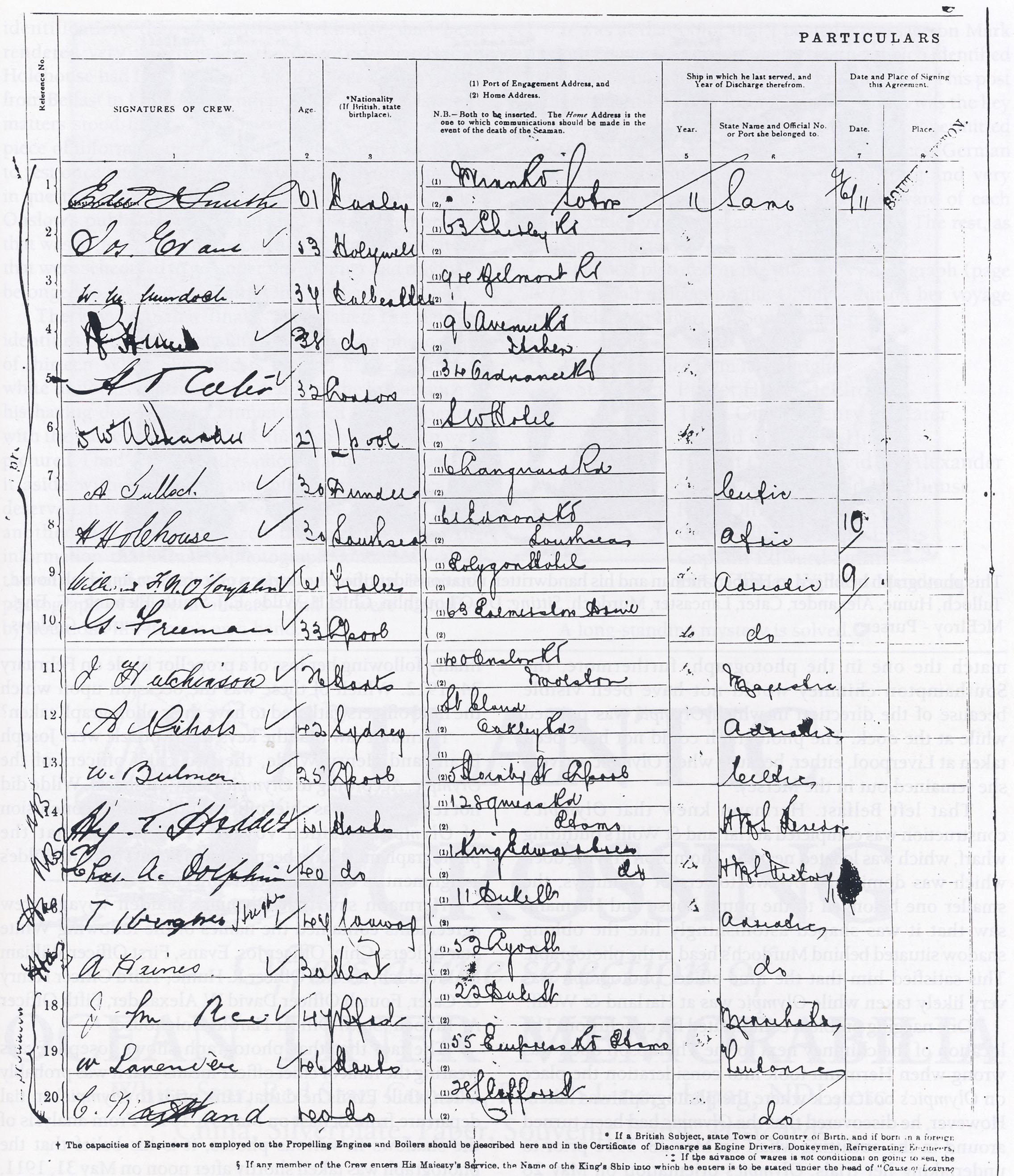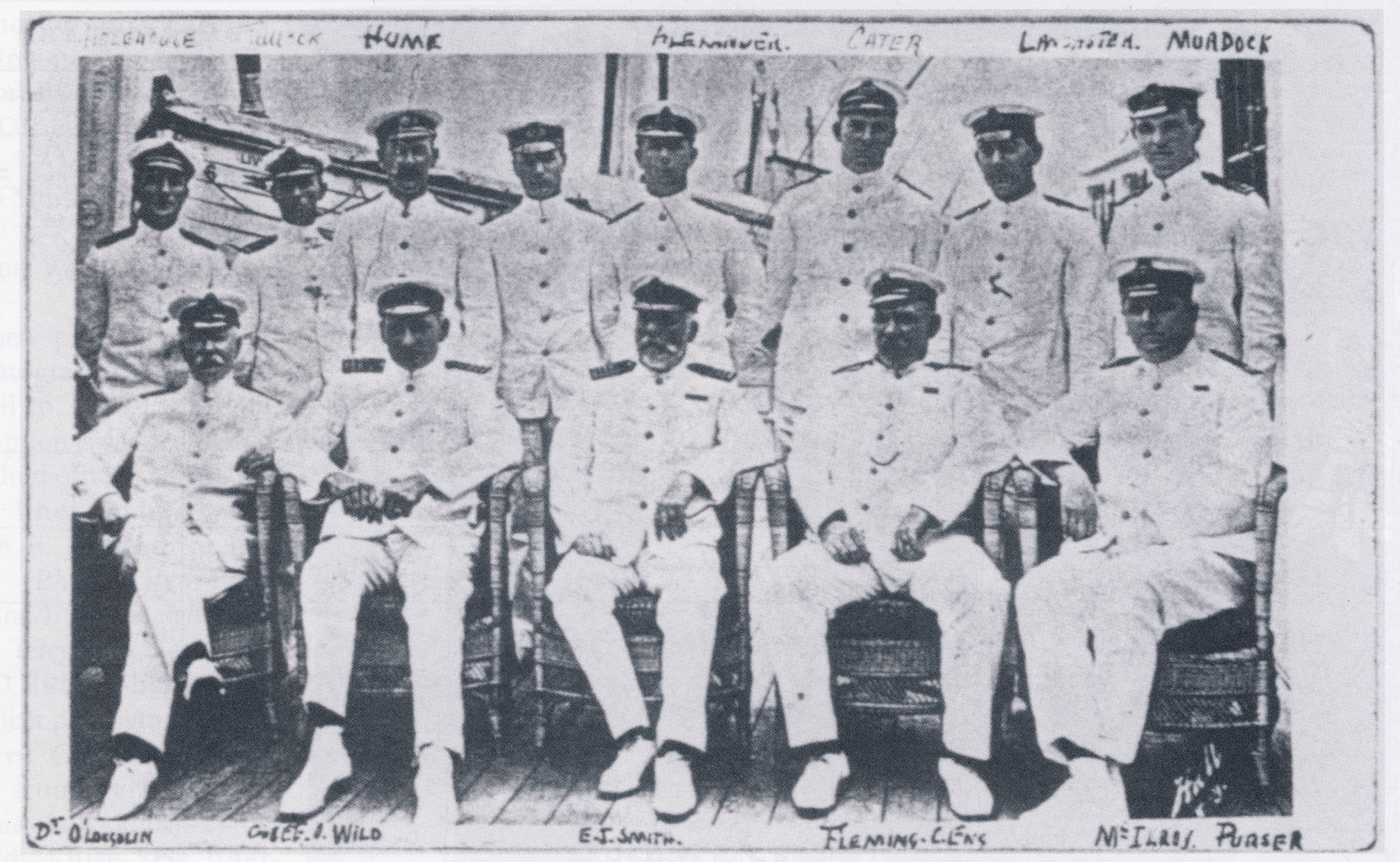
The original postcard was printed in 1912; it was widely believed that this photograph was the officers
who sailed on the Titanic's maiden voyage. (Courtesy George Behe Collection)

In 1912, immediately after the Titanic disaster, a memorial postcard (see above) was issued picturing nine White Star officers dressed in the Line's dark winter uniform. The caption on this postcard stated: "Captain Smith and officers S.S. Titanic." Indeed, three of the men in the photo (Captain Edward Smith, First Officer William Murdoch and Purser Hugh McElroy) were readily identifiable as genuine Titanic officers, and it has generally been assumed that the other six officers were indeed the men whose names we have become familiar with during our studies about the Titanic disaster.
In recent years a number of Titanic books have included this 'nine-officer photograph' among their illustrations, and the authors of some of these books (most notably Peter Thresh) attempted to put names to the faces of the lesser-known officers. Thresh did this by matching the visible rank markings on the officers' uniforms with the known ranks of the officers who definitely served on the Titanic; the officers whose rank markings were not visible in the photo were 'identified' by matching their facial resemblance to actual Titanic officers who are pictured in other photos of unquestionable authenticity. The identifications that Thresh arrived at by these methods were, from left to right, as follows:
Standing: McElroy, Lightoller, Pitman, Boxhall, Lowe.
Seated: Moody, Wilde, Smith, Murdoch.
Several researchers have always been uncomfortable with these purported identifications, though, simply because a few of the officers in the photo did not resemble likenesses of Titanic's officers that were taken at other times and in other circumstances. This uncertainty led to continued efforts to determine if the identifications arrived at by Peter Thresh were indeed accurate.
In 1996 a new piece to the puzzle came to light during a research trip that the present author made to Indiana. While perusing the April 17, 1912 issue the "Fort Wayne Daily News" I came upon a photograph of four White Star officers -- all of whom were identified in the caption beneath the photograph (see immediately below). The men in the photo were Captain Smith, First Officer Murdoch, J. Evans and an officer named Alexander. I immediately sat up and took notice, because Evans and Alexander were clearly and recognizably two of the officers who appeared in the 'nine-officer photo' that Peter Thresh believed was a photo of Titanic's full complement of officers.

The fact that two of the men in the 'nine-officer photo' were not really Titanic officers at all suggested that the photo had nothing to do with Titanic's maiden voyage, but how could we be sure about that? Four officers in the photo were still unidentified, and there was at least a slim chance that one or more of them might truly have been Titanic officers.
Our next step in the identification process occurred when relatives of a former White Star officer contacted THS historian Don Lynch. These people told Don that the officer standing on the far right side of the photo was their relative, Maurice Parkhouse.* Even though it later turned out that this identification was incorrect, it still suggested that the men in the photo were not all Titanic officers as had formerly been claimed.
Meanwhile, on the other side of the Atlantic, German researcher Hermann Soeldner was conducting his own study of the 'nine-officer photo.' Hermann knew that the photo had been snapped on the boat deck of a liner, so in April of 1999 he tried to determine the name of the ship upon which the photograph had been taken.
Unfortunately, the background of the 'nine-officer photo' in question was a bit overexposed photographically, and consequently it is difficult to make out many background features that would otherwise be visible. However, Hermann examined a slightly different version of the 'nine -officer photo' that was taken at the same time as the one we have been discussing. (This second photo depicts the same men but in slightly different poses.) The second photo is much darker in appearance than the first, and its background features are more clearly visible; it showed enough background detail (air-shafts, davits, compass platform, railings etc.) to enable Hermann to determine that both photos were taken on board the Olympic, that the camera was facing aft and that the officers were seated on the boat deck beside the raised roof of the reading and writing room. He knew that the photo depicted the Olympic (and not the Titanic) because of the distinctive placement of certain ventilators that are visible in other photographs of both ships.
Being fairly certain that all nine officers in the photo were probably Olympic officers instead of Titanic officers, Hermann then contacted the Public Record Office and obtained copies of some of Olympic's early crew sign-on sheets. Upon receiving these documents he discovered that Joseph Evans was indeed Olympic's chief officer during the period prior to the completion of Olympic's June 14th, 1911 maiden voyage. Moreover, David W. Alexander was listed as Olympic's fourth officer throughout that same time period.
Without additional information upon which to base further identifications, Hermann looked at Olympic's sign-on sheets and noted the ages of the officers who served on board the vessel on her maiden voyage; he then speculated (incorrectly, as it turned out) about the probable identities of the remaining unidentified officers in the photo based upon their apparent ages. Hermann published all of his above findings in the June 1999 issue of "The Navigator," journal of the German Titanic Society.
After the publication of his above article, Hermann's next challenge was to determine where the Olympic had been located when the 'nine-officer photo' was taken. Hermann knew that Joseph Evans was Chief Officer until the conclusion of Olympic's maiden voyage. Three important pre-maiden voyage opportunities for taking photographs immediately suggested themselves to Hermann: Olympic's departure from Belfast on May 31st, 1911, her arrival at the intermediate waypoint of Liverpool on June 1st, or her arrival at the port of Southampton prior to the commencement of her maiden voyage on June 14, 1911.
The only way to resolve this question was discover exactly where the ship had been located when the 'nine-officer photo' was taken. Hermann did this by searching for recognizable terrain features in the background of the photo, and he found one single object that he thought it might be possible to identify -- a 'shadow' (resembling a tower or chimney) that is faintly visible behind the head of First Officer Murdoch.
Hermann knew that such a chimney existed in Southampton, but he also knew that its shape didn't quite match the shape in the photo; furthermore, the Southampton chimney would not have been visible in the photo because of the direction in which Olympic was pointed while at the dock. The photo could not have been taken at Liverpool, either, because when Olympic arrived there she remained far outside on the Mersey.
That left only Belfast. Hermann knew that Olympic's construction was completed at Harland and Wolff's outfitting wharf, which was located right beside the Thompson dry-dock. The dry-dock was dominated by two towers or chimneys; one of these, the smaller, belonged to the pumping-house, and Hermann saw that it was shaped astonishingly like the oblong shadow situated behind Murdoch's head in the photo. This satisfied Hermann that the 'nine-officer photo' was very likely taken while Olympic was still in the Harland & Wolff shipyard.
One nagging problem complicated this conclusion, though. The location of the Thompson dock chimney was wrong when Hermann took into consideration the place on Olympic's boat deck where the photo was taken. However, Hermann then discovered that the Olympic had been turned around in the outfitting wharf on May 28th, 1911 prior to undertaking her trials; Olympic's orientation on May 28th would have put the chimney in exactly the right place to show up in the photograph.
Having determined that the photo was taken at H&W in Belfast, Hermann next tried to determine exactly when it was taken. He knew that Olympic was in Belfast a number of times: first, during her initial construction; next on October 6th, 1911 for repairs after her collision with the Hawke; and finally, following her loss of a propellor blade on February 24th, 1912. Which of these was the occasion upon which the nine officers gathered to have their photo taken?
Hermann saw that the keys to the puzzle were Joseph Evans and Henry Wilde, the two chief officers of the Olympic. According to Olympic's sign-on sheets, Wilde did not replace Evans as chief officer until after the conclusion of Olympic's maiden voyage. This meant that the 'nine-officer photo' must have been taken in Belfast prior to Wilde's assignment as Olympic's chief officer.
Hermann saw that Olympic's maiden voyage crew agreements (see below) contained the names of the following White Star officers: Chief Officer: Jos. Evans 1st. Officer: William M. Murdoch 2nd. Officer: R. Hume 3rd. Officer: Henry O. Cater 4th. Officer: David W. Alexander 5th. Officer: A. Tulloch 6th. Officer: Harold H. Holehouse.

The fact that the 'nine-officer photo' shows Joseph Evans wearing the rank of chief officer means that the photo was probably taken while Evans held that rank prior to Olympic's initial departure from Belfast on May 31, 1911. From analysis of the shadows in various photos, it is Hermann's belief that the 'nine-officer photo' was taken shortly after noon on May 31, 1911, just prior to Olympic's departure for Liverpool, Southampton and the commencement of her maiden voyage. Hermann published all of this supplementary research in the December 1999 issue of "The Navigator."
To recap, by this point definite identifications had been made for two of the unidentified men in the 'nine-officer photo: Chief Officer Joseph Evans and Fourth Officer David W. Alexander. A third identification, that of 'Maurice Parkhouse,' had been rendered very uncertain by the discovery that Harold H. Holehouse had been Olympic's sixth officer on her voyage from Belfast to Liverpool/Southampton. And that is where matters stood for the next few months -- until a crucial piece of information came to light which put the subject to rest once and for all.
As it turned out, the information in question had actually been available to researchers since 1993 when Onslows auction house published their catalog of Titanic memorabilia that was to be auctioned in April of that year. Several items that were scheduled to go under the hammer in that auction had originally belonged to the Titanic's Third Officer, Herbert Pitman.
The key item which finally established the definite identities of the men in the 'nine-officer photo' was Pitman's copy of a photograph of thirteen White Star officers dressed in summer white uniforms (see below). Without ever realizing the importance of his having done so, Mr. Pitman labeled his photograph with the names of twelve of the thirteen officers who were pictured in the photograph. The present author had glanced at this photo in 1993 and set then it aside without examining it with the care it deserved. It was only in late February of the year 2000 that I took another look at Pitman's photo and realized the importance of the information it contained; all of the officers pictured in the 'nine- officer photo' were also present in Pitman's photo of thirteen officers -- and all were identified by notations in Pitman's own hand.

It was at that point that I posted a message on Mark Taylor's "Titanic Discuss List" (on the Internet) which publicly identified every man who is present in the 'nine-officer photo.' This post indicated that Pitman's annotated photograph was the key item which finally unraveled the mystery, since it permitted the matching of specific names to specific faces. German researcher Susanne Stormer saw my posting and very kindly made Hermann Soeldner and me aware of each other's independent research on this subject. The rest, as they say, is history.
The men pictured in the 'nine-officer photo' at the top of this article were all officers on the Olympic during her voyage from Belfast to Liverpool/Southampton and, from left to right, are identified as follows:
Standing: Purser Hugh McElroy, Third Officer Henry O. Cater, Second Officer R. Hume, Fourth Officer David W. Alexander, Sixth Officer Harold H. Holehouse.
Seated: Fifth Officer A. Tulloch, Chief Officer Joseph Evans, Captain Edward Smith and First Officer William Murdoch.
A long-standing historical mystery solved at last.
* (Note: Maurice Parkhouse turned out to be an able bodied
seaman who served on board the Olympic).